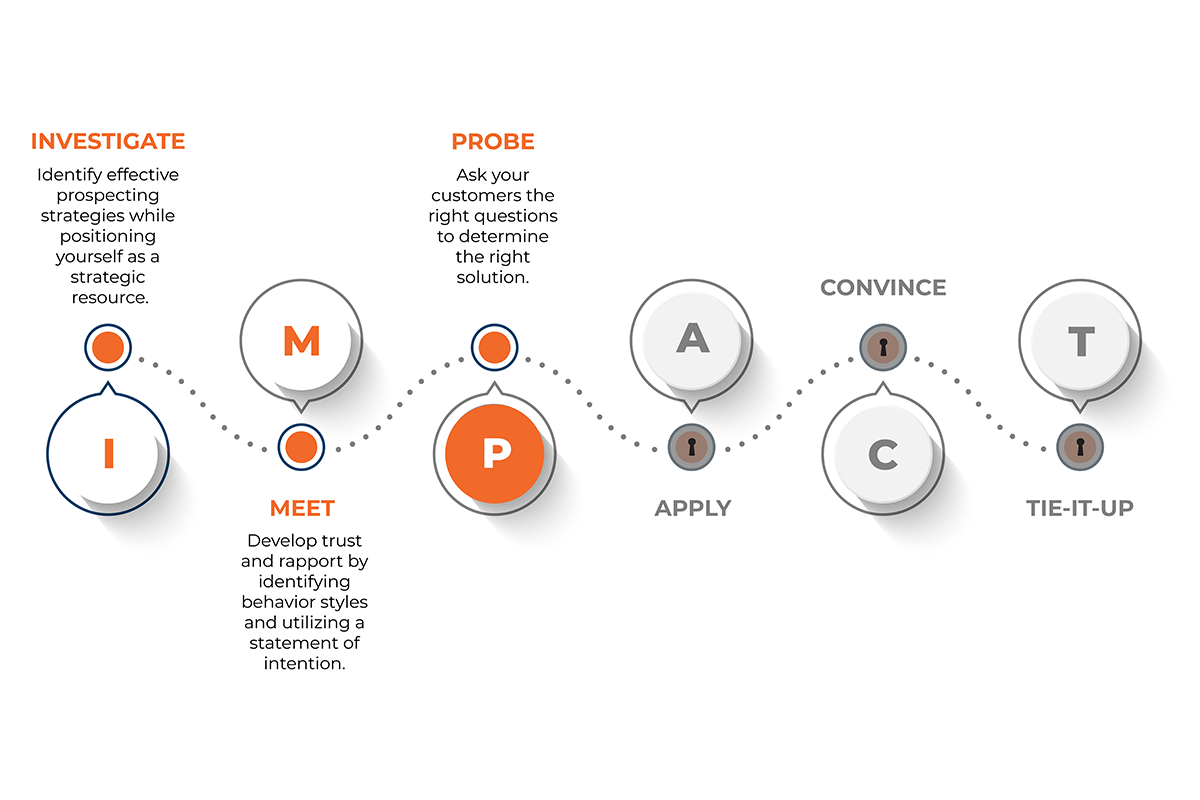This article is part of our Key Fundamentals of IMPACT Selling® series.
The Importance of Asking Probing Questions
The Probe step is one of the most important in the IMPACT Selling® process but is often underappreciated and taken for granted. Most sellers know they have to ask questions; they know that those questions should be open-ended, and that those questions are used to identify pain points. But knowing these things does not make someone skilled at discovery. In reality, our data tells us otherwise.
At The Brooks Group, we asked over 100 salespeople to take our IMPACT Selling Skills Index® (SSI) assessment before and after going through our flagship IMPACT Selling® Sales Training, which focuses heavily on Probing and questioning techniques. In our baseline assessment, questioning ability in the Probe step scored the lowest on average among the six IMPACT categories. But this skill also saw the greatest percentage improvement after sales training with scores up 23%.
Yes, poor discovery is a problem, but helping your team improve their questioning ability can make a big difference in their performance and sales success.
An Area of Misplaced Confidence
Why do we assume we and our teams are good at asking probing questions? The answer is simple: we’ve talked extensively (and for many years) about the need to do it. There are books full of ideas, opinions, and tips to follow. But just because the ideas are out there doesn’t mean we’re good at putting them into practice.
When sellers watch their own behavior, they are often surprised by how much they talk about themselves. They rush to present, instead of slowing down to understand what the customer wants. It’s easy to fall into the trap of assuming we know what the customer wants without asking.
“What Do You Want?”
If you don’t understand what the customer wants to do, then you can’t truly appreciate what they need to buy. But sellers have conditioned both themselves and their customers to assume that every question is some form of “What do you want to buy?”
There’s a great scene from the classic movie “Field of Dreams”. Ray Kinsella (played by Kevin Costner) and Terence Mann (James Earl Jones) are walking through Fenway Park. They stop and Ray asks, “What do you want?”. Terence goes off on a rant about all his pain, desires, and what he wants to see in the world. He opens his soul to Ray. The camera angle changes to reveal that the two men are standing in front of a concession stand. Ray gestures to it and restates his question, “No… what do you want?”
Terence realizes his mistake and replies “Oh. Dog and a beer.”
We all laugh. But why is the scene funny? Because it’s counterfactual. In 99 times out of 100, we would interpret “What do you want?” as “What do you want to acquire?”, or “What do you want to buy?” not “What do you hope will happen?” or “What do you wish was different in your life?”
If we are to truly help our customers, don’t we want those customers to interpret the question as Terence did and give us the type of information Terence gave? The answer is yes. But this is why it’s not enough to just ask questions or even ask open-ended questions. We need to ask questions that customers understand are intended to explore their situation more deeply, and we need customers to feel comfortable answering those questions deeply and honestly.
Stop Sending Mixed Signals
At The Brooks Group, we teach sales professionals to use an open-ended, three-deep questioning strategy in their discovery. The goal is to uncover the wants that lie beneath the need to buy. I like a simple statement that defines this layering, “I need to buy something because I want to do something.” The goal is for the customer to reveal (in Terence Mann fashion) what they want to do or want to happen.
Too often salespeople get stuck asking superficial, “concession stand” level questions and fail to dig beneath the surface. As I mentioned, most customers are jaded by order-taker salespeople. If they don’t believe you actually care about deeper problems and desires—why would they share them with you? They’ll just ask for your “dog and a beer” product and then beat you up on the price.
This is where sellers must be very careful about the signals they send. When you lead with talking about your product, you send “concession stand” level signals. When you put pressure to make decisions fast, when you have not prepared for deeper discussion about the customer’s business, when you don’t listen critically, and when you don’t show curiosity, you signal little interest in discussing deeper wants.
This drives the tendency of customers to delay engaging with salespeople in their buying journey. They reason, “Right now I’m figuring out what I want to do. I’ll come to you when I know what I need to buy.”
Three Steps To Getting What You Want
So, what’s the solution? Help your team confidently engage in the Probe step. When speaking to customers, you must send consistent signals that you are interested in going deeper to understand what the customer wants to do.
Here are three steps that will support you in doing that:
1. Conduct thorough research before engaging with the customer.
Do your homework to understand and think critically about the customer’s situation, priorities, and possible concerns before you ask probing questions. There is a big difference between the questions: “What are your biggest concerns?” and “How are you managing through the slower material supply chains that seem to be hitting you and others in your space?” One signals curiosity and depth of thinking, the other signals more of an interest in having the customer do the deep thinking for you.
2. Listen actively and ask follow-up questions.
Pay close attention to the customer’s responses so you can ask curious, relevant follow-up questions that dive deeper into what the customer wants. Push yourself to find the point where the customer responds, “That’s a good question.” You’ve found the point of uncertainty, the point at which they aren’t exactly clear on the parameters of their wants. Now you can explore together and provide valuable perspective as they refine that want.
3. Make personalized recommendations.
Make recommendations relevant to the customer’s specific wants and problems, recommendations that should only partly involve buying something. If you’re interested in doing deep thinking for the customer (and you should be) make sure your recommendations include creative, novel things the customer can do with what you plan to sell them.
This is where the apply step comes in, as the salesperson provides the customer with a valuable solution tailored to their specific needs and wants.
Train Your Team To Ask Better Questions
It’s important to note that implementing these steps effectively requires a certain level of skill and experience. Salespeople need to be trained with the right techniques and strategies to use during the Probe step as well as how to actively listen and make personalized recommendations.
If anyone on your team struggles with this, our IMPACT Selling® System can help. Each progressive step of IMPACT builds upon the last, giving your team the skills they need and a proven process they can follow to unlock successful selling. Feel free to reach out if you’d like to talk about your team’s sales training needs or to learn more about any of our trainings and assessments, like the IMPACT Selling Skills Index® (SSI) mentioned earlier.




